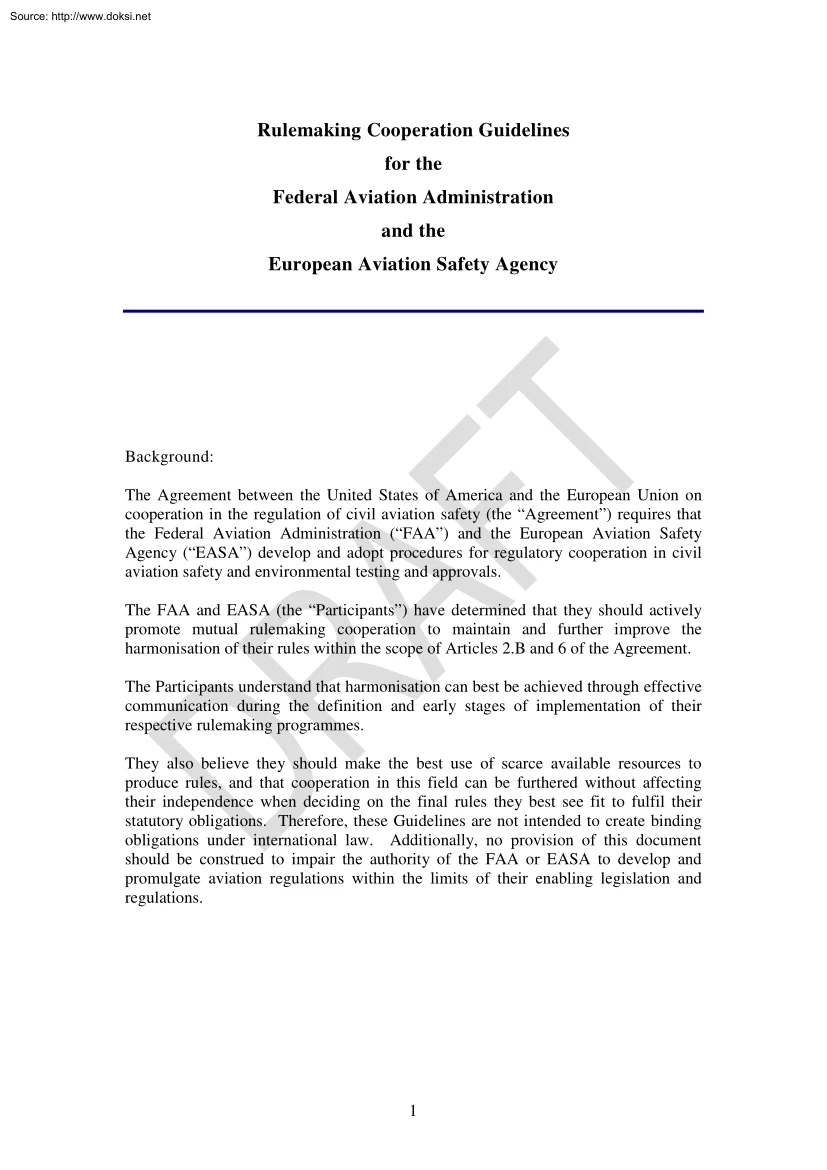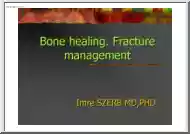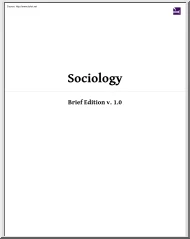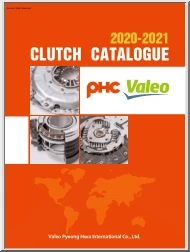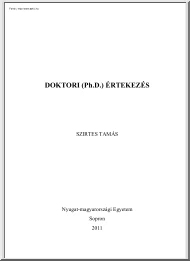Datasheet
Year, pagecount:2014, 7 page(s)
Language:English
Downloads:1
Uploaded:October 08, 2018
Size:614 KB
Institution:
[FAA] Federal Aviation Administration
Comments:
Attachment:-
Download in PDF:Please log in!
Comments
No comments yet. You can be the first!Content extract
Source: http://www.doksinet Rulemaking Cooperation Guidelines for the Federal Aviation Administration and the European Aviation Safety Agency Background: The Agreement between the United States of America and the European Union on cooperation in the regulation of civil aviation safety (the “Agreement”) requires that the Federal Aviation Administration (“FAA”) and the European Aviation Safety Agency (“EASA”) develop and adopt procedures for regulatory cooperation in civil aviation safety and environmental testing and approvals. The FAA and EASA (the “Participants”) have determined that they should actively promote mutual rulemaking cooperation to maintain and further improve the harmonisation of their rules within the scope of Articles 2.B and 6 of the Agreement The Participants understand that harmonisation can best be achieved through effective communication during the definition and early stages of implementation of their respective rulemaking programmes. They also
believe they should make the best use of scarce available resources to produce rules, and that cooperation in this field can be furthered without affecting their independence when deciding on the final rules they best see fit to fulfil their statutory obligations. Therefore, these Guidelines are not intended to create binding obligations under international law. Additionally, no provision of this document should be construed to impair the authority of the FAA or EASA to develop and promulgate aviation regulations within the limits of their enabling legislation and regulations. 1 Source: http://www.doksinet I. Objectives 1) These Guidelines establish the process through which the FAA and EASA intend to promote rulemaking co-operation in the early stages of the rulemaking process. 2) The objectives of this rulemaking cooperation arrangement are to: i. Exchange rulemaking intentions and priorities of the Participants to align as much as possible their respective rulemaking
programmes; ii. Identify rulemaking initiatives of common interest that through regulatory collaboration would allow the FAA and EASA to: (i) avoid unnecessary divergence and duplication of work, (ii) maximize available resources, and (iii) further harmonisation. iii. Define the corresponding working methods (as described under Article IV) to be followed by the Participants when executing tasks which have been identified as of ‘common interest’ under Article III; II. Scope 1) Subject to Articles 2.B and 6 of the Agreement, the scope of these Guidelines includes rulemaking initiatives related to Title 14, Code of Federal Regulations and equivalent European Union rules for which proposals are developed by EASA, as well as to related acceptable means of compliance, certification specifications, advisory circulars, guidance material, and technical standard orders. 2) Activities related to the issuance of airworthiness directives, equivalent safety findings and special conditions
for individual certification projects are outside the scope of this rulemaking cooperation arrangement. III. Project Management 1) Management of the FAA and EASA in charge of rulemaking intend to meet at least twice a year in the April and November time frame, preferably by videoconference, to: i. Review the functioning of this rulemaking cooperation arrangement. ii. Discuss their current and future rulemaking programmes, including priorities thereof and related documentation. To that end, the FAA and EASA intend to exchange on a regular basis their respective rulemaking programmes, and information on their implementation in accordance with Attachment I of these Guidelines. 2 Source: http://www.doksinet iii. Identify rulemaking activities of common interest, and corresponding working methods. iv. Discuss possible changes in the rulemaking programmes and working methods imposed by changing priorities. v. Discuss possible contentious issues. 2) The FAA and EASA intend to
develop an agenda for these meetings at least three weeks before the meeting. 3) The FAA and EASA intend to maintain an up to date inventory of rulemaking tasks that have been identified as being of common interest, including identification of the focal points and information on the types of common actions agreed to and their current status. Where appropriate, the FAA and EASA intend to make available to the public the list of rulemaking tasks of common interest and status of the work. 4) Representatives of the FAA and EASA responsible for rulemaking may attend the meetings of the joint coordination bodies established under the Agreement, such as the Certification Oversight Board, Joint Maintenance Coordination Board, and Bilateral Oversight Board to ensure, inter alia, that the discussions on rulemaking cooperation in the above bodies are consistent with the overall priorities identified under these Guidelines. The Participants intend that attendance at meetings at the Bilateral
Oversight Board be in accordance with the provisions of the Board’s Internal Governing Procedures. IV. Implementation and Selection of Working Methods 1) The FAA and EASA intend to use one of the following working methods to execute rulemaking tasks, which the Participants have identified as “tasks of common interest,” with the objective to make best use of available resources and expertise on both sides. “Tasks of common interest” may include newly initiated rulemaking projects of either Participant affecting a precisely defined domain (e.g all rulemaking projects affecting certification specifications for CS / Part 25 airplanes). The selection of a working method should take into account the benefits for aviation safety and for the aviation sector, and complexity of the subject. Working Method # 1 - EASA Takes the Lead The general process is the EASA rulemaking procedure. This working method aims at giving the FAA sufficient involvement in the EASA rulemaking project to
understand the content of the draft rule and to be able to contribute to this process as necessary to allow it, where appropriate, to launch an equivalent Notice of Proposed Rulemaking (“NPRM”) or take other equivalent rulemaking decision. 3 Source: http://www.doksinet The EASA focal point should lead the rulemaking process in regular coordination with the FAA focal point. The EASA focal point should ensure that communication takes place for the following phases of the EASA process: - When drafting the terms of reference of the task; - When deciding changes in the terms of reference; - Prior to the publication of the Notice of Proposed Amendment (“NPA”). Working Method #2 - FAA Takes the Lead The general process is outlined in the FAA Office of Rulemaking’s Rulemaking Manual. This working method aims at giving EASA sufficient involvement in the FAA’s rulemaking project to understand the content of the NPRM and be able to contribute to this process as necessary to
allow it, where appropriate, to launch an equivalent NPA or take other equivalent rulemaking decision. As appropriate, the FAA focal point should lead the rulemaking process in regular coordination with the EASA focal point. The FAA focal point should ensure that communication takes place for the following phases of the FAA process: - When developing issue papers in preparation for drafting the Rulemaking Action Plan (“RAP”); - When selecting the membership of an ARAC (“Aviation Rulemaking Advisory Committee”) or Aviation Rulemaking Committee (“ARC”) to allow EASA participation; - During the deliberations of an ARAC or ARC up to and including publication of the final reports; - When deciding changes to the scope of the rulemaking project prior to the development of the RAP. Working Method #3 – Authorities Cooperation Under this method, the FAA and EASA intend to develop their rulemaking projects separately, but concurrently (to the extent practicable). However, as
appropriate, the FAA and EASA focal points may follow the process 4 Source: http://www.doksinet described in Working Methods #1 and #2 in sharing information during concurrent development of the rule. 2) The Participants may exchange technical experts, at their own cost. Exchanges of personnel should be addressed in separate written arrangements between the Participants. 3) For each task identified as a “task of common interest” the Participants intend to assign a focal point responsible for coordinating the work. V. FAA Ex Parte Communications To the extent that the FAA engages in any ex parte communications with EASA after approval of the RAP until publication of the final rule and receives significant information and argument from EASA respecting the merits of the proposed rule, the FAA will provide a summary of those discussions in the rulemaking docket. VI. Work Plans 1) For each rulemaking project selected, EASA and FAA intend to develop a work plan. Each work plan
should describe the following: VII. i. Working method; ii. Technical points of contact; iii. Project implementation schedule and meeting dates; iv. Description of the technical documents that either the FAA or EASA intends to make available for review and discussion. These may include jointly developed issue papers, analyses, research results and other technical documents of a non-confidential nature, except that the FAA and EASA, if their national procedures or rules so require, may decide not to make available copies of documents, such as in the case of the FAA, the RAP, or the NPRM prior to publication in the Federal Register; v. Participation in work groups, e.g ARAC and ARCs; and vi. Any other cooperative activities mutually determined by EASA and the FAA to be beneficial. Release of Data Except as required by applicable law, neither the FAA nor EASA should disclose to any third party confidential or pre-decisional rulemaking information received from the other
Participant as a result of that Participant’s involvement in any rulemaking 5 Source: http://www.doksinet Source: http://www.doksinet Attachment 1 Rulemaking Programmes Documents to be provided by EASA: Type of document Monthly rulemaking scoreboard 4-year rulemaking programme Frequency of exchanges Focal Point athanassios.tziolas@easaeuropaeu once a month annually athanassios.tziolas@easaeuropaeu Documents to be provided by FAA: Type of document Frequency of exchanges Rule status reports once a month AC and Orders1status once a month 4-year rulemaking lookahead annually 1 Focal Point For the FAA, ACs and Orders are promulgated by the specific Line of Business and not by the Office of Rulemaking. 7
believe they should make the best use of scarce available resources to produce rules, and that cooperation in this field can be furthered without affecting their independence when deciding on the final rules they best see fit to fulfil their statutory obligations. Therefore, these Guidelines are not intended to create binding obligations under international law. Additionally, no provision of this document should be construed to impair the authority of the FAA or EASA to develop and promulgate aviation regulations within the limits of their enabling legislation and regulations. 1 Source: http://www.doksinet I. Objectives 1) These Guidelines establish the process through which the FAA and EASA intend to promote rulemaking co-operation in the early stages of the rulemaking process. 2) The objectives of this rulemaking cooperation arrangement are to: i. Exchange rulemaking intentions and priorities of the Participants to align as much as possible their respective rulemaking
programmes; ii. Identify rulemaking initiatives of common interest that through regulatory collaboration would allow the FAA and EASA to: (i) avoid unnecessary divergence and duplication of work, (ii) maximize available resources, and (iii) further harmonisation. iii. Define the corresponding working methods (as described under Article IV) to be followed by the Participants when executing tasks which have been identified as of ‘common interest’ under Article III; II. Scope 1) Subject to Articles 2.B and 6 of the Agreement, the scope of these Guidelines includes rulemaking initiatives related to Title 14, Code of Federal Regulations and equivalent European Union rules for which proposals are developed by EASA, as well as to related acceptable means of compliance, certification specifications, advisory circulars, guidance material, and technical standard orders. 2) Activities related to the issuance of airworthiness directives, equivalent safety findings and special conditions
for individual certification projects are outside the scope of this rulemaking cooperation arrangement. III. Project Management 1) Management of the FAA and EASA in charge of rulemaking intend to meet at least twice a year in the April and November time frame, preferably by videoconference, to: i. Review the functioning of this rulemaking cooperation arrangement. ii. Discuss their current and future rulemaking programmes, including priorities thereof and related documentation. To that end, the FAA and EASA intend to exchange on a regular basis their respective rulemaking programmes, and information on their implementation in accordance with Attachment I of these Guidelines. 2 Source: http://www.doksinet iii. Identify rulemaking activities of common interest, and corresponding working methods. iv. Discuss possible changes in the rulemaking programmes and working methods imposed by changing priorities. v. Discuss possible contentious issues. 2) The FAA and EASA intend to
develop an agenda for these meetings at least three weeks before the meeting. 3) The FAA and EASA intend to maintain an up to date inventory of rulemaking tasks that have been identified as being of common interest, including identification of the focal points and information on the types of common actions agreed to and their current status. Where appropriate, the FAA and EASA intend to make available to the public the list of rulemaking tasks of common interest and status of the work. 4) Representatives of the FAA and EASA responsible for rulemaking may attend the meetings of the joint coordination bodies established under the Agreement, such as the Certification Oversight Board, Joint Maintenance Coordination Board, and Bilateral Oversight Board to ensure, inter alia, that the discussions on rulemaking cooperation in the above bodies are consistent with the overall priorities identified under these Guidelines. The Participants intend that attendance at meetings at the Bilateral
Oversight Board be in accordance with the provisions of the Board’s Internal Governing Procedures. IV. Implementation and Selection of Working Methods 1) The FAA and EASA intend to use one of the following working methods to execute rulemaking tasks, which the Participants have identified as “tasks of common interest,” with the objective to make best use of available resources and expertise on both sides. “Tasks of common interest” may include newly initiated rulemaking projects of either Participant affecting a precisely defined domain (e.g all rulemaking projects affecting certification specifications for CS / Part 25 airplanes). The selection of a working method should take into account the benefits for aviation safety and for the aviation sector, and complexity of the subject. Working Method # 1 - EASA Takes the Lead The general process is the EASA rulemaking procedure. This working method aims at giving the FAA sufficient involvement in the EASA rulemaking project to
understand the content of the draft rule and to be able to contribute to this process as necessary to allow it, where appropriate, to launch an equivalent Notice of Proposed Rulemaking (“NPRM”) or take other equivalent rulemaking decision. 3 Source: http://www.doksinet The EASA focal point should lead the rulemaking process in regular coordination with the FAA focal point. The EASA focal point should ensure that communication takes place for the following phases of the EASA process: - When drafting the terms of reference of the task; - When deciding changes in the terms of reference; - Prior to the publication of the Notice of Proposed Amendment (“NPA”). Working Method #2 - FAA Takes the Lead The general process is outlined in the FAA Office of Rulemaking’s Rulemaking Manual. This working method aims at giving EASA sufficient involvement in the FAA’s rulemaking project to understand the content of the NPRM and be able to contribute to this process as necessary to
allow it, where appropriate, to launch an equivalent NPA or take other equivalent rulemaking decision. As appropriate, the FAA focal point should lead the rulemaking process in regular coordination with the EASA focal point. The FAA focal point should ensure that communication takes place for the following phases of the FAA process: - When developing issue papers in preparation for drafting the Rulemaking Action Plan (“RAP”); - When selecting the membership of an ARAC (“Aviation Rulemaking Advisory Committee”) or Aviation Rulemaking Committee (“ARC”) to allow EASA participation; - During the deliberations of an ARAC or ARC up to and including publication of the final reports; - When deciding changes to the scope of the rulemaking project prior to the development of the RAP. Working Method #3 – Authorities Cooperation Under this method, the FAA and EASA intend to develop their rulemaking projects separately, but concurrently (to the extent practicable). However, as
appropriate, the FAA and EASA focal points may follow the process 4 Source: http://www.doksinet described in Working Methods #1 and #2 in sharing information during concurrent development of the rule. 2) The Participants may exchange technical experts, at their own cost. Exchanges of personnel should be addressed in separate written arrangements between the Participants. 3) For each task identified as a “task of common interest” the Participants intend to assign a focal point responsible for coordinating the work. V. FAA Ex Parte Communications To the extent that the FAA engages in any ex parte communications with EASA after approval of the RAP until publication of the final rule and receives significant information and argument from EASA respecting the merits of the proposed rule, the FAA will provide a summary of those discussions in the rulemaking docket. VI. Work Plans 1) For each rulemaking project selected, EASA and FAA intend to develop a work plan. Each work plan
should describe the following: VII. i. Working method; ii. Technical points of contact; iii. Project implementation schedule and meeting dates; iv. Description of the technical documents that either the FAA or EASA intends to make available for review and discussion. These may include jointly developed issue papers, analyses, research results and other technical documents of a non-confidential nature, except that the FAA and EASA, if their national procedures or rules so require, may decide not to make available copies of documents, such as in the case of the FAA, the RAP, or the NPRM prior to publication in the Federal Register; v. Participation in work groups, e.g ARAC and ARCs; and vi. Any other cooperative activities mutually determined by EASA and the FAA to be beneficial. Release of Data Except as required by applicable law, neither the FAA nor EASA should disclose to any third party confidential or pre-decisional rulemaking information received from the other
Participant as a result of that Participant’s involvement in any rulemaking 5 Source: http://www.doksinet Source: http://www.doksinet Attachment 1 Rulemaking Programmes Documents to be provided by EASA: Type of document Monthly rulemaking scoreboard 4-year rulemaking programme Frequency of exchanges Focal Point athanassios.tziolas@easaeuropaeu once a month annually athanassios.tziolas@easaeuropaeu Documents to be provided by FAA: Type of document Frequency of exchanges Rule status reports once a month AC and Orders1status once a month 4-year rulemaking lookahead annually 1 Focal Point For the FAA, ACs and Orders are promulgated by the specific Line of Business and not by the Office of Rulemaking. 7
